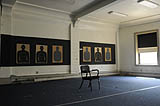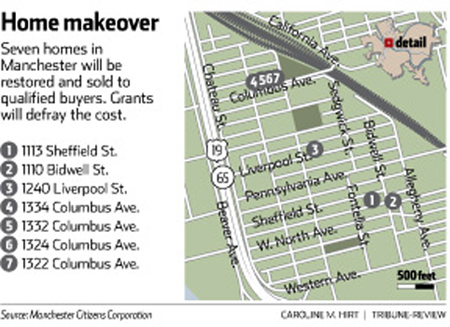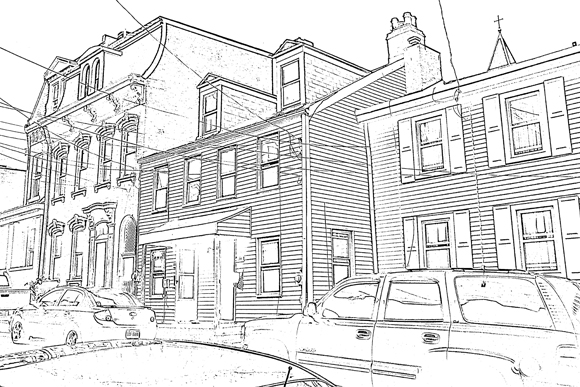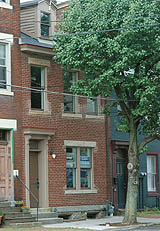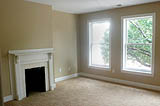
Category Archive: Property for Sale
-
Historical Group Seeks Bell From Kittanning’s Town Hall
by Renatta Signorini
Leader Times
Thursday, September 9, 2010
KITTANNING A local group is on a quest to find a bell that once stood high above Market Street in Kittanning’s former town hall.
Joie Pryde has driven plenty of back roads in search of the bell without luck.
“We are on a quest to acquire that bell, restore it” and get boroough permission to place it in Riverfront Park, Pryde said.
It’s the latest mission of the Kit-Han-Ne Questers, a group of local residents dedicated to the preservation and restoration of historic sites and artifacts. The group is hosting the 11th annual Antiquing Along the Allegheny this Saturday in an effort to raise money for reatoration of the bell if they ever find it.
This year’s Antiquing Along the Allegheny features about 60 vendors sprawled out in Kittanning Riverfront Park, selling antiques and handmade crafts including toys, furniture and glassware. Quester Carolyn Schrecengost said some vendors are local residents who don’t have their own shops.
“We have them coming from all around,” said Quester Rovena Chauvaux.
She will be one of the vendors using the event to make room at own home for more antiques. Chauvaux said she will be selling vases, toys and Christmas decorations, among other items.
The local chapter of the Questers is linked to the International Questers, an antique study group with members in the United States and Canada. The group requires that chapters spend any money raised on restoration projects.
In the past, the Kit-Han-Ne Questers have restored stained glass windows, the portraits of four judges in the courthouse and old theater seats.
The project completed with funds from last year’s antiquing event was purchasing three lights for the kitchen and dining room at the McCain House Museum in Kittanning that are now on display.
“We wanted to get the time period suitable,” Chauvaux said.
The new lights are circa 1900 and replaced fixtures that were from a more recent time period.
“Really, they stuck out like a sore thumb, especially the ones in the kitchen because they were obviously ’50s,” Pryde said.
She has gotten a variety of information on the local bell that once hung in Kittanning’s town hall, which was located in the building that now houses First National Bank, but has not had luck finding the piece of local history. Pryde said she has learned that the bell is apparently dated 1906 and could be located somewhere in the Harrison Township area.
Historical societies in that area have made mention of a “bell haven” that was once in a collectors yard, but Pryde has not been able to locate it.
“We’ve hit a dead end everywhere,” she said.
-
Fire Engine House in North Point Breeze Up for Sale
Offers due Oct. 22; tour set ThursdayMonday, September 06, 2010By Joe Smydo, Pittsburgh Post-Gazette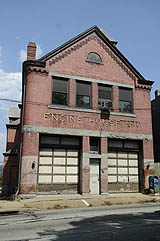
The Engine No. 16 firehouse in North Point Breeze is up for sale. Proposals for use of the space are due Oct. 22 and guidelines are posted for would-be purchasers. Rebecca Droke/Post-Gazette
The fire trucks and alarm bells may be long gone, but city officials believe Engine House No. 16 still has a dynamic role to play in the East End.
Officials said they’d like to sell the building and have posted guidelines for would-be purchasers. The request for proposals is on www.buyintheburgh.com, a year-old database of properties for sale by the city and Urban Redevelopment Authority.
The two-story, red-brick building is at Penn and North Lang avenues in North Point Breeze. Built in the early 1900s, it has 6,500 square feet of space and an appraised value of $90,000. Other features are two drive-in bays, 16-foot ceilings and a full basement.
The engine house’s name still adorns the front of the structure.
“It’s a gorgeous building,” said URA executive director Rob Stephany.
The city stopped using the building as a fire station in the late 1980s or early 1990s, but it’s still used to provide classroom training to firefighters. Overall, the URA said, it’s in fair condition.
Mr. Stephany said the building is well suited for an architect’s studio, condominiums or a home-business combination. Claire Hosteny, URA senior real-estate development specialist, said one drawback is a lack of parking space outside.
Proposals are due to the URA by noon Oct. 22. A walk-through is scheduled for 9 a.m. Thursday.
No public subsidies are available for renovation. The URA is helping to vet proposals, but the decision to sell rests with City Council and the mayor’s office.
In other cities, old firehouses have been converted into homes and businesses. In March, Chicago officials decided to seek redevelopment proposals for the old Engine Co. 18 firehouse, a two-bay structure built in 1873 on the city’s Near West Side. Officials said they’re interested in a commercial or mixed-use development.
Mr. Stephany said redevelopment of the North Point Breeze building can have a “catalytic impact” on a part of the city poised for progress. He said the development opportunity comes amid a master-planning process for the Homewood-North Point Breeze area.
In highlighting the firehouse development opportunity last week, officials also sought to focus renewed attention on the property website, which lists about 4,300 properties for sale. Properties may be searched by address and neighborhood. The website provides details on each property and has information on the city’s tax-abatement and green-up programs.
-
McKees Rocks’ Miles Bryan School May Become Condos
Thursday, September 09, 2010By Brian David, Pittsburgh Post-GazetteThe Miles Bryan School building is beautiful in a way modern schools seldom are, with a Gothic flavor and spires and gargoyles carved into its stone.
It’s also in a beautiful spot, on six wooded acres atop a hill jutting up in the midst of McKees Rocks.
The 83-year-old former school has a spectacular view, with the Pittsburgh skyline floating above the treetops to the east and an overview of the town’s rolling hills.
And it boasts a unique bit of landscaping with its terraced levels and sweeping, 102-step grand staircase winding down the hill to Chartiers Avenue.
That’s the good. The bad is that Miles Bryan, vacant since 1997, has been targeted by vagrants and vandals and is marked by graffiti and broken glass.
It is in a struggling community where redevelopment is too often an underfunded dream. And with no one to do official maintenance, a handful of volunteers faces the task of keeping weeds and brush at bay on the grounds.
“I get poison ivy five times a summer up there,” said Taris Vrcek, director of the McKees Rocks Development Corp. and the chief maintenance volunteer.
Mr. Vrcek, however, hopes to put the Calamine lotion away for good in a few years. The CDC, which has an option on the property, is marketing it to developers, touting it as a site for 20 to 30 luxury loft condominiums.
“We see Miles Bryan as a viable and marketable property,” he said Tuesday. “We’re seeking a developer with the imagination to share our vision of what is possible.”
As part of that mission, the CDC on Friday hosted the second annual “Run Your Rox Off” 5K run/walk, which started and finished at Miles Bryan and included a community picnic and free concert.
Mr. Vrcek said the event raised roughly $2,000 for the CDC, but more importantly, it attracted between 300 and 400 to the site, including a high percentage of out-of-town runners.
“The fundraising is definitely secondary to raising awareness,” he said.
Miles Bryan was built in 1927 on an outcropping known as O’Donovan’s Hill, part of the landholdings of telegraph-operator-turned-merchant-banker Michael C. O’Donovan. It was named for a banker and politician who was also a scion of the family that built the Frank Bryan Inc. concrete company.
The building served as the high school for McKees Rocks children until 1966, when McKees Rocks and Stowe merged to form the Sto-Rox School District, then served as Sto-Rox Middle School for another 31 years.
Facing a steep renovation bill, the school district closed it in 1997 and sold it to a developer in 2001. The CDC holds an option with that developer.
Mr. Vrcek said he spent one year there, as a seventh-grader in 1981-82, but has “more memories from there than from anywhere else.”
He remembered the separate rooms for art, wood shop and music, the gym and auditorium and especially the trees.
“It was so easy to focus there; you had trees outside your window and not much else,” he said. “You felt removed from the world up there.”
He also remembered playing on the grounds before and after school, and the long walk up the hill from Chartiers Avenue, where children got off the buses. “It immediately promoted good health, making all the kids walk up that hill,” he said.
Mr. Vrcek said the classrooms are between 1,000 and 2,000 square feet with high ceilings and large windows and would convert easily to apartments. He said that eight of them would most likely boast the skyline view.
The gymnasium, he said, could be used for either sheltered parking or as a fitness center, and the auditorium could get windows and skylights and serve as an atrium-style gathering place or even as an indoor greenhouse/garden.
Mr. Vrcek also said the CDC is interested in keeping the grounds open to the public, while balancing that interest with the privacy and safety concerns of prospective owners.
Duquesne Light has been an active donor to CDC efforts, he said, and he is looking to the utility company’s Power to Light program to get some lighting on the grounds.
Mr. Vrcek said that Duquesne Light also is planning to do cleanup work in Third Street Park, which adjoins the Miles Bryan grounds, as a Day of Caring Project on Tuesday. The park has been closed since the mid-90s, and the CDC is hoping to find funding for new equipment and safety measures to get it open again.
“Talking to young people around here, I know that kids desperately want some decent park space, some decent green space,” he said.
Mr. Vrcek said the hope is to have a developer on board for the Miles Bryan project within 12 months. He is looking at a five-year time frame to have lofts on the market.
-
Shuttered N. Point Breeze Firehouse Draws Interest
By Adam Brandolph
PITTSBURGH TRIBUNE-REVIEW
Thursday, September 9, 2010
Last updated: 10:22 am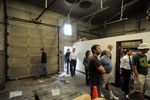
A former firehouse and Pittsburgh police training center at the corner of Penn and North Lang avenues was opened up this morning for potential buyers to get a look in Point Breeze. James Knox/Pittsburgh Tribune-Review
High ceilings, plenty of garage space, a classroom and a shooting range.
City officials believe Engine House No. 16 will make a great renovation.
“We want to see proposals, but we don’t have a preconceived notion of what we’re looking for,”said Claire Hosteny, senior real estate development specialist for the Urban Redevelopment Authority. “We’re just really excited because of the potential impact it could have on the neighborhood.”
Officials are seeking a buyer of the two-story brick building, located at North Lang and Penn avenues in North Point Breeze. About 30 people attended a tour of the property this morning.
The request for proposals can be found online at www.buyintheburgh.com. Bids are due Oct. 22.
The 6,500-square-foot building, which dates to the early 1900s, was last used as a firehouse in the late ’80s or early ’90s and has since been used as a police and fire training area. It is appraised at $90,000.
Eric Townsend of Forest Hills said the building’s nonexistent parking would be a problem if he decided to turn it into a nonprofit art studio.
“I’m just looking at everything and trying to get an idea of what’s available,” Townsend said.
Some architects and other potential investors touring the building said it would likely cost upward of $500,000 to renovate, but costs would fluctuate depending on what was done.
“I’ve never seen a turnout like this for a city property before,” said Michael Whartnaby of Point Breeze. “There’s definitely an interest.”
-
7 Homebuyers Sold on Manchester Vision
By Adam Brandolph
PITTSBURGH TRIBUNE-REVIEW
Thursday, September 2, 2010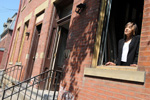
Linda Nelson, chairwoman of the Manchester Citizens Corporation, inspects one of the properties being restored on Columbus Avenue in Manchester. The home was purchased as part of the Great House Sale. Jasmine Goldband | Tribune-Review
For the first time in years, Anthony Clark sees a reason to invest in his North Side neighborhood.
“Manchester is really starting to get going, and after 15 years of renting, I think it’s a good time,” said Clark, 44. “I think we’re about to see some really great things.”
For years, the city demolished vacant homes in Manchester, turning usable buildings into weed-filled lots that became overrun with graffiti and trash. The vacant lots made selling homes difficult, and people living there say the community suffered despite the fact that police records show the number of crimes fell by nearly half over the past decade.
“When you have a tooth out, the disease begins to spread,” said Linda Nelson, chairwoman of the Manchester Citizens Corporation, a community group founded in 1965 that helped spur more than $40 million in developments and initiatives. “If (buildings) come out, it’s definitely a hindrance. If we can renovate them, it’s a plus.”
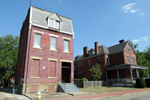
An abandoned structure (left) on the 1100 block of Bidwell Street in Manchester is one of several slated for rehabilitation. Jasmine Goldband | Tribune-Review
With the group’s managing director Stanley Lowe urging the city to save buildings from demolition, the wrecking ball slowed. Along with the Pittsburgh History & Landmarks Foundation, it identified 110 buildings that should be saved, 63 of which are considered a priority.
Lowe said he reminded members of the city’s Historic Review Commission about the neighborhood’s rich architectural and cultural heritage, which helped Manchester achieve city and national historic status in 1979.
“Once you tear down the building, you can never go back,” Lowe said.
In October, the citizens’ group showcased seven homes to be restored by March. More than 100 people, some from as far away as Venezuela and Colombia, attended a two-day session that included a seminar educating them about how to buy one of the homes.
Twenty-five people put down $1,500 deposits, and seven qualified buyers were chosen at random to buy the homes. The rest were put on a waiting list for future restorations.
“The homes were a terrible mess,” Nelson said. “But the people who came in saw our vision.”
The cost to restore each home will range from $150,000 and $450,000, but they will sell for $90,000 to $200,000.
Incentives totaling $2 million for the buyers will be paid by grants from the city’s Urban Redevelopment Authority, the federal Department of Housing and Urban Development, Allegheny County, the Pittsburgh History & Landmarks Foundation’s Landmarks Community Capital Corporation and the Allegheny Foundation.
City Councilman R. Daniel Lavelle, whose district includes Manchester, said the strategy “fits the city’s economic reality.”
“The city can’t afford to do it all at once, so (the citizens’ group has) identified key properties they want to save,” Lavelle said. “I think it’s a tremendous project.”
Preserving the “architectural fabric” of the historic district has been ongoing since the 1970s, said Arthur Ziegler, president of the landmarks foundation.
Rob Stephany, executive director of the redevelopment authority, said the restorations are a “really bright strategy,” especially because they’re near construction at Columbus Square, a $15 million, 31-home development on four acres.
“Manchester has everything working for it,” he said.
-
Downtown’s EQT Plaza No Longer on the Block
‘Recapitalization’ shinier than sellingWednesday, September 01, 2010By Mark Belko, Pittsburgh Post-GazetteThe owner of one Downtown building has removed its “for sale” sign.
Rather than sell, New York-based Blackstone Group has decided to retain ownership of EQT Plaza, formerly known as Dominion Tower, and refinance its debt.
“They just decided with the way the markets are today, a recapitalization was a better option for them,” said Gerard Sansosti, executive managing director of HFF Inc. in Pittsburgh, which was marketing the building for sale.
Aaron Stauber, president of New York-based Rugby Realty, which has extensive property holdings in Pittsburgh, said refinancing was an attractive option for building owners these days because of very low interest rates. One advantage to refinancing rather than selling, he noted, is that the owner does not have to pay capital gains taxes.
HFF had announced in February that it was putting the 32-story office building, now the headquarters of EQT Corp., up for sale on behalf of Blackstone, which bought it for $45 million through a sheriff’s sale in 2005.
While HFF had received offers for the 23-year-old building, located on Liberty Avenue, Mr. Sansosti said Blackstone ultimately decided not to sell.
“I think it’s going to be off the market for a while,” he said.
As of February, the 615,942-square-foot office tower was about 96 percent leased. EQT moved into the building from the North Shore last year.
EQT Plaza was one of a handful of high-profile buildings Downtown to go up for sale this year, sparking a wave of publicity and even inquiries from city hall about the reasons for the moves.
Others on the market include the landmark Macy’s department store (formerly Kaufmann’s); the four-building Gateway Center complex, the linchpin of the city’s first renaissance; the Henry W. Oliver Building; the Regional Enterprise Tower, formerly the Alcoa Building; and American Red Cross of Southwestern Pennsylvania building, Boulevard of the Allies.
-
E Properties & Development Restore Abandoned Lawrenceville Houses
Wednesday, September 01, 2010
E Properties and Development is nearing completion on the transformation of two blighted properties on 38th Street in Lawrenceville, contributing to the major revitalization efforts taking place on the hill between Butler Street and Penn Avenue.
The two connected townhouses at 234 38th Street sat neglected for some time, until E Properties and Development principal Emeka Onwugbenu purchased them last June.
“In terms of challenges, people suggested that the properties be demolished,” says Onwugbenu. “Our team of architects and engineers created value-based solutions that would restore the structural stability of each building while building on its architecture.”
Onwugbenu and architect Andrew Moss extended the foundations of the houses to create a more open environment with two added rooms, and installed bamboo floors throughout the buildings. They are also raising the second and third floors, and installing clear story windows, which will allow light to pour through the master bedrooms that will open into unique balcony decks overlooking downtown. The exterior, which is currently composed of vinyl siding, will be swapped out for cement board side material. Coldwell Banker has signed on to market the homes, which will start in the low $200,000 range, and are slated for move-in by Thanksgiving.
Onwugbenu, originally from Nigeria, attended Penn State for industrial engineering, and is currently in his final semester of the MBA program at CMU. He started E Properties and Development in 2007, in order to create unique value-added properties, which mix traditional design with a modern feel.
In addition to the homes at 234 38th Street, architect Andrew Moss is currently building his dream home one block away at 221 38th Street. Two other homes, at 236 and 238 38th Street, are currently being renovated by private owners, within steps of the 234 buildings.
Sign up to receive Pop City each week.
Source: Emeka Onwugbenu, principal of E Properties and Development
Writer: John FarleyImage courtesy Emeka Onwugbenu
-
Buying Here: Deutschtown
Saturday, July 17, 2010By Kevin Kirkland, Pittsburgh Post-GazetteEven by North Side standards, 621 Tripoli St. was a challenge.
The original 1890s brick townhouse was intact, but the later wood-frame addition on the back was crumbling and falling away, and raccoons had made themselves at home. Worst of all to an old-house lover, someone had cut into the front facade and installed a picture window, probably in the 1970s.
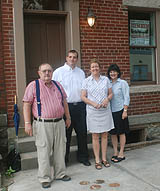
Members of the Northside Leadership Conference, from left, are Bernard Beck, president of East Allegheny Community Council; Greg Jones; Nancy Noszka, director of real estate for the Northside Leadership Conference; and Teekie Smith, Coldwell-Banker agent. Larry Roberts/Post-Gazette
The window is history now, as is the early 20th-century addition, replaced by a new wood-frame rear section containing the kitchen, part of the dining room and a second-floor bedroom. The two-bedroom, 11/2-bath house is on the market for $219,900 through Teekie Smith of Coldwell Banker Real Estate’s Shadyside office (412-708-1588 or www.pittsburghmoves.com, MLS No. 826966).
Ms. Smith says the house is a perfect blend of old character and new amenities.
 Deutschtown:
Deutschtown:
At a glance- Website: www.deutschtown.org
- Size: .236 square miles
- Population: 2,635 (2000 census)
- School district: Pittsburgh Public, www.pghboe.net
- Enrollment: about 28,000
- Average SAT scores: 358 verbal; 383 math; 362 writing (2009, Oliver High School)
- Taxes for a house assessed at $100,000: $2,941; County: $469 (4.69 mills); City: $1,080 (10.8 mills); School: $1,392 (13.92 mills)
- Wage tax: 3 percent (1 percent to the city, and 2 percent to the school district)
- A bit of history: Deutschtown — also known as East Allegheny and Dutchtown — dates back to the mid-1800s and grew as the City of Allegheny expanded eastward. As its name implies, it was once the heart of Pittsburgh’s German-speaking community. It is still headquarters for the 150-year-old Teutonia Maennerchor, the largest German singing society and social club in the region. The neighborhood was added to the National Register of Historic Places in 1983.
“The developers have tried their hardest to preserve anything original,” she said. “The hardware is wonderful. There are locks and latches that I’ve never seen before. But it’s also got new floors, air conditioning, a second-floor laundry, off-street parking [two spaces] and a big backyard.”
This is the fifth project in the past 10-15 years involving the Northside Leadership Conference and East Allegheny Community Council, says Greg Jones, project manager for the Northside Leadership Conference. Al Depasquale and October Development were the general contractors on this renovation and another at 517 Tripoli. Mr. Depasquale is also the developer and contractor on three new houses going up around the corner on James Street.
In late 2008 and early 2009, October Development finished building three new brick houses and renovating two old ones in the 900 block of James. The three new townhouses sold for $229,000 each and the old ones for $190,000 and $165,000, respectively.
“The new ones sold before construction,” Mr. Jones noted. “The speed and price were unprecedented in this area.”
This part of the North Side is usually called East Allegheny or Historic Deutschtown in recognition of its large German population in the late 19th century. It was divided by construction of the Parkway North in the 1980s. Many century-old brick townhouses remain, along with more modest wood-frame dwellings. Some have been renovated, but not as many as in nearby Allegheny West and the Mexican War Streets, where houses are generally more expensive.
Mr. Jones said buyers are fairly evenly divided between young professionals and older empty-nesters, many of whom are familiar with the North Side and its historic yet affordable housing stock.
“They say, ‘My friend bought one in this neighborhood.’ It’s a limited supply but a heck of a market. They often sell by word of mouth,” he said.
“These people have an interest in historic restoration. They know what they’re getting into. They get a house with some character that has a story to it.”
Adding to the attraction is a 10-year abatement on city and school property taxes and a three-year abatement on county taxes that can save buyers as much as $30,000 to $40,000, he said. Depending upon income, they may also qualify for a second, deferred mortgage, Ms. Smith said.
The home at 621 Tripoli is unusual in that it was renovated with no public subsidy through funding from the Northside Community Development Fund. The design/build process used reduced the need for an architect and sped construction. Luckily, many of the old doors and much of the hardware and trim were reusable, as was the original staircase and mantels on the two decorative fireplaces. Preservation expert Nick Kyriazi, a longtime member of the East Allegheny Community Council, even came up with old lighting fixtures for the first floor.
“They were restored and rewired. They’re stunning,” Ms. Smith said.
Although the front parlor and floor plan were retained, the new rear section is very open, with granite countertops in the new 13-by-13-foot kitchen. The new powder room is tucked away nearby, and the large modern bathroom upstairs serves bedrooms measuring 17 by 15 feet and 17 by 13 feet, respectively, each with large closets. The developers opted to make the third floor a storage area rather than living space (the ceiling height is only about 6 feet).
The East Allegheny Community Council bought the property for $9,900 in June 2008, and its assessed market value is $9,000 (www2.county.allegheny.pa.us). Five properties have sold on Tripoli in the past three years for prices ranging from $17,500 in July 2009 to $215,000 in September 2009 for the October Development rehab at 517 Tripoli. One property sold twice (www.realstats.net).
This house is three blocks away from Allegheny General Hospital and Allegheny Commons Park and 5-10 minutes waking distance from Downtown, Heinz Field and PNC Park. An open house will be held from 1 to 4 p.m. this Sunday and next Sunday.

